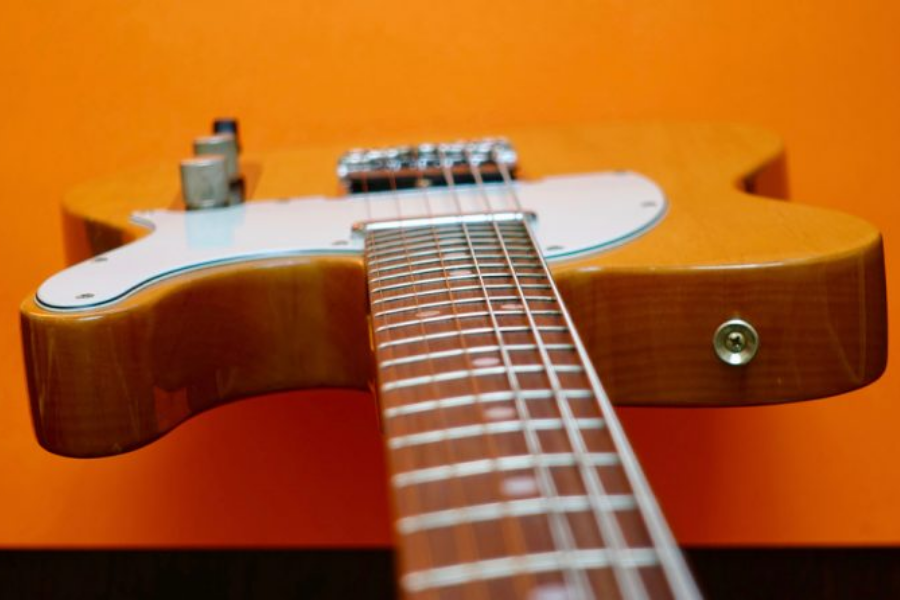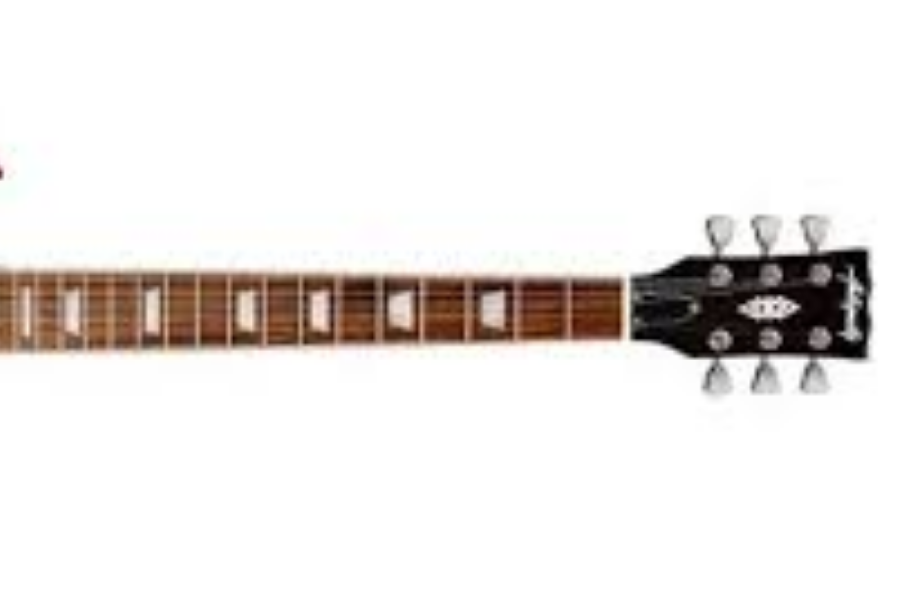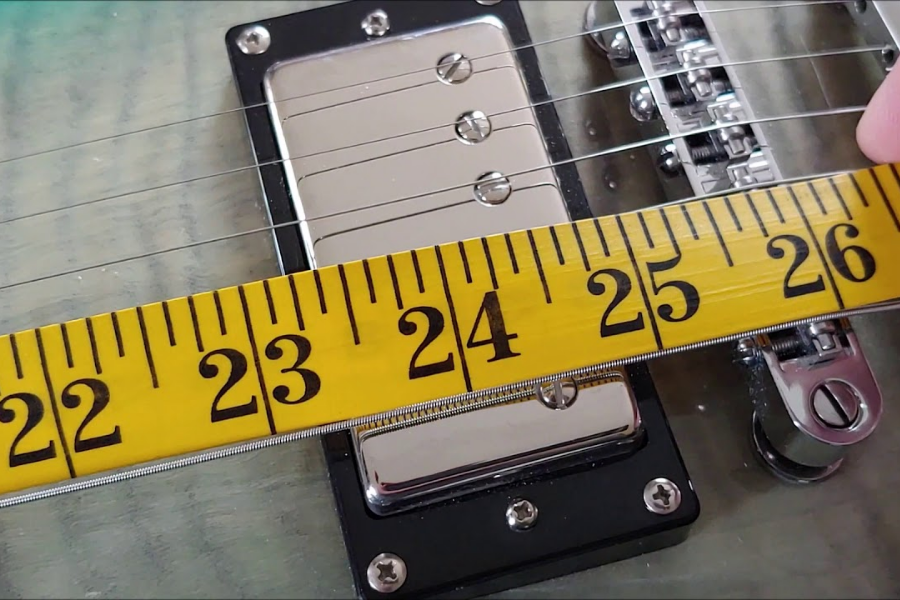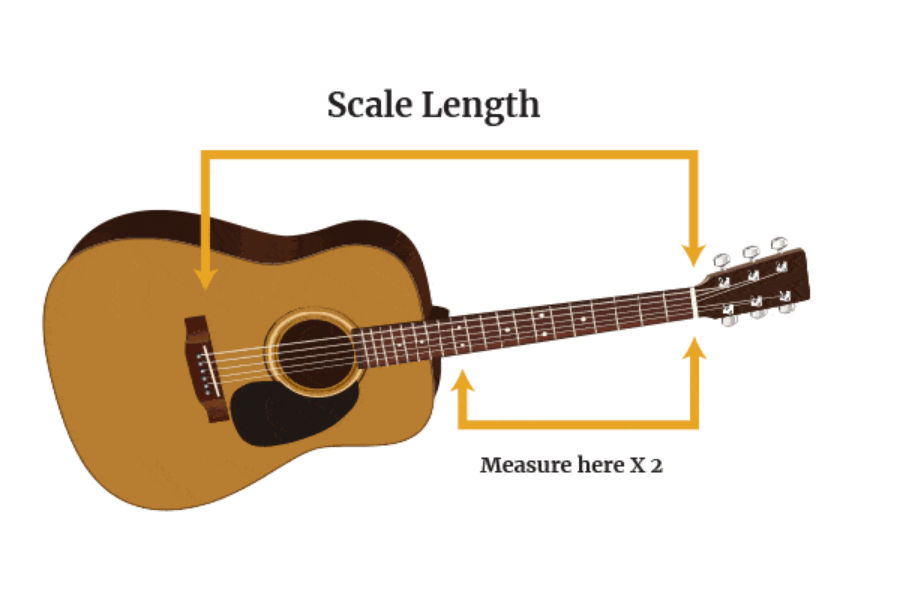There are a number of factors to consider when choosing an electric guitar, from number of strings to types of pickup. One critical aspect usually forgotten by many guitarists is the guitar scale length. And if you look closely enough, you’ll see that some guitars will have scale lengths that are different to others.
In this guide, Eguitarmania covers everything you would want to know about guitar scale length. From understanding the basic definition to exploring how different scale lengths impact on your instrument’s performance and tone. Prepare to discover how this one element can enhance your musical expression and enjoyment.

What Is Guitar Scale Length?
Guitar scale length refers to the distance between the nut and the bridge. The more specific explanation is from the point between the neck and headstock where the strings start to where the strings anchor to the body. Different types of guitars use different scale lengths, typically ranging from 24 inches to 26.5 inches.
Many parts of a guitar can be adjusted to your liking, but the scale length is fixed. A lot of Fender types, like Stratocaster and Telecaster, have scale lengths that are 25.5 inches, which is the most popular length. On most Gibson electric guitars, the 24.75-inch neck width is also very common.
There are three primary categories of acoustic guitar scale lengths:
- Long Scale: Guitars with a long scale are between 25.5 and 26.5 inches long, and their strings are tighter and the tones are a little louder. Many players like these guitars because they have more sustenance and are good for players who want more power and extension.
- Standard Scale: Standard scale lengths, which are between 24.75 and 25.5 inches, are flexible and work for a lot of different playing styles. They find the right mix between the strain of the strings, the distance between the frets, and the sound.
- Short Scale: Short-scale guitars have scale lengths between 24 inches and 24.75 inches. They are easier to play because the strings aren’t pulled as tight, which is great for players who find longer scale lengths difficult. They work well with blue and rock music.

Why Does Guitar Scale Length Matter?
If you understand how scale length impacts the setting and feel of your guitar, it will be much easier to make the necessary changes. Here’s why the choice of guitar scale length can greatly impact your playing experience and the sound:
Feel & String Tension
The string strain is the most important thing that scale length changes. When the scale length is longer, the strings are usually more tense, making it a little harder to play. When the scale length is shorter, the strings feel less tense.
As an example, let’s compare a Gibson Les Paul (24.75″ scale) and a Fender Stratocaster (25.5″ scale). Even using the same gauge strings and tuning, you would notice that the Gibson is slightly easier to perform bends and vibrato compared to the Fender.
Fret Spacing
The scale length also affects the spacing between frets. The fret spacing probably won’t have a big effect on how easy it is to play for most players. Maybe a different scale length guitar will work better for you if your hands are big or small.
Guitars with longer scale lengths have wider spacing, which can be great for soloing and fretting tough chords. Shorter scale lengths are often favored by players who prefer fingerpicking, or players with smaller hands looking for something a bit more comfortable.
Tone and String Gauge
The scale length influences the way the strings vibrate and interact with the guitar’s body. String gauge also affects tension and you can change your string gauge to increase or decrease the tension as you need. A longer scale length guitar will require higher tension to bring the strings up to tune.
On the other hand, shorter scale lengths can contribute to warmer, mellower tones. The key point to remember is that you need to think about scale length and string gauge together.
Guitar designers often adjust scale length to optimize an instrument for a particular purpose. Guitarists use longer scales to get the added punch and volume that the higher string tension can produce. By contrast, shorter scales, which yield thicker, warmer sounding trebles and warm basses with a smooth attack.

How To Measure Guitar Scale Length?
While you could try to measure a guitar’s scale length by measuring the distance between the nut and the bridge, you’re not going to get an accurate result. Each string has a different length to compensate for intonation.
As a result, calculating scale length from the nut to the bridge would give slightly different measurements depending on which string you measured!
A better way is measuring from the nut to the 12th fret and then multiplying that number by two to get the total value. Many guitars, including acoustic and electric guitars, can be measured using the same method.
For example, you may find a Stratocaster from the nut to the 12th fret, and get the measurement of 12.75″. Now just need to double it, you will get the correct scale length of 25.5”. Just that easy!
Common Scale Lengths
Here we have collected some famous guitar models’ scale lengths:
| BRAND AND MODEL | SCALE LENGTH |
| Ibanez & ESP | 27” |
| Fender Jaguar / Mustang / Duo Sonic | 24” |
| Gretsch (various models) | 24.6” |
| Ibanez Artcore (various models) | 24.7” |
| Gibson Les Paul / SG / Designer / ES | 24.75” |
| PRS Custom 24 | 25″ |
| Jackson Soloist | 25.5″ |
| Schecter, Ibanez, ESP & Chapman | 26.5” |
By far, the most common scale lengths you’ll find are 24.75′′ and 25.5′′. Scales that are 25.5 inches are also common on many new Ibanez, ESP, Schecter, and Chapman guitars.

To accommodate modern players who might like guitar tones that are punchier and clearer, especially metal fans. For example, you’ll find that many of the companies that draw inspiration from Gibson‘s instruments maintain the shorter scale lengths that Gibson popularized.
Final thought
Scale length is one of the fundamental building blocks of picking the perfect guitar for a player. This tiny aspect can have a strong impact on feel, tone, and performance.
Selecting the right acoustic guitar scale length is a personal decision that depends on its playability, tone and sound. Understanding it, even to a basic level, will go a long way in helping you to correctly set up your guitar.









